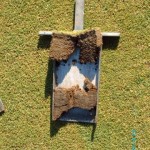
As bowling green maintenance specialists we get lots of questions every week about thatch. So here is a quick crash course on it; what it is, what it does and how to deal with it:
What is it?
Thatch is the name given to the mat of dead roots and shoots that accumulates on the surface of the green. Where moisture, nutrition and cultural practices are optimised for the desired grasses, thatch rarely becomes a problem. However, when soil air content is low, or if drainage is poor and the fertiliser program is not optimised for the prevailing conditions, thatch can become a problem. In severe cases the major root mass might only exist within this layer and this leaves the green susceptible to drying out in summer and to the heads “skinning” (loss of turf cover) in wet weather. Thatch is also a major contributor in the encouragement of fungal pathogens like fusarium and can cause severe outbreaks of disease to occur if left unchecked. Thatch is also a major contributor to localised dry patch problems on greens
What causes thatch?
Thatch and compaction are very closely linked. When the soil becomes overly compacted due to foot and maintenance traffic, oxygen levels within the green reduce significantly. The aerobic (oxygen loving) micro-organisms (soil microbes) within the soil that break down thatch and release nitrogen that can be used by the grass plants to flourish need oxygen to thrive. The microbe population reduces drastically with reduced oxygen supplies.
What can be done?
Summer
Physical reduction of thatch is the first step. This can be started during the bowling season by pencil tining to allow more air into the soil and regular verti-cutting to keep lateral growth under control.
You also need to get on to a proper nutritional program which doesn’t use heavy applications of granular fertilisers. Spoon fed bio liquid programs are best as these provide carbohydrate which boosts grass health and increases microbial activity.
Autumn
Then in autumn you should get serious with the thatch using various methods such as hollow tining and deep, heavy duty scarification (slotting such as Graden).
Winter
In winter you need to deep slit tine your green as often as you possibly can when conditions allow (not when it is too wet or when there is frost)
Performance Bowling Greens a practical guide has a full step by step system for improving your bowling green including getting to grips with thatch.
